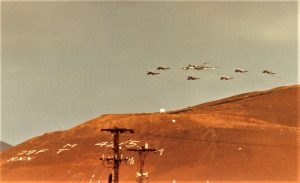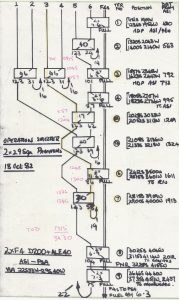I am indebted to Bob Tuxford for recording his experiences as the formation leader covering the arrival of the second element of F4s arriving on Ascension from Coningsby on the 8th October and also the initial wave onwards to provide the air defence of Falklands airspace – an operation codenamed Operation Smelter.
Bob writes:
From the onset of the ‘Operation Corporate’, Royal Air Force Harrier GR.3s had been earmarked to reinforce the Royal Naval Harrier FRS.1s. During the first few weeks of the War, Harriers based on Ascension Island undertook the air defence of the British military forces stationed on the forward operating base in the mid-Atlantic. Following their onward deployment in support of the Task Force, the Harriers were replaced on 24 May 1982 by Phantom FGR.2s of No.29 Sqn. In the aftermath of the Argentinian surrender, four Phantoms were deployed to Ascension Island on 18 September 1982 as the first element of the air defence unit destined for Port Stanley airfield on the Falkland Islands. On 8 October, the remaining compliment of two aircraft were deployed to bring the flight up to a strength of six aircraft. After the runway at Port Stanley had been extended to accommodate the fast jets, all six aircraft were refuelled by Victor tankers to the Falkland Islands under ‘Operation Smelter’.
Flypast on 8th October 1982 at the Governor’s Residence – Ascension Island
On 8th October 1982, two Phantom FGR.2s of No.29 Sqn were refuelled in-flight by Victor K2 tankers from the UK en-route to Ascension Island. They would bring up to a total of six, the number of air defence Phantoms on the forward operating base. To complete the last segment of their deployment, my crew was tasked to rendezvous (RV) with the inbound pair and refuel them over the remaining sector from abeam Dakar to Ascension Island. I recall the AOC No.18 Group was visiting Ascension that day and he was planned to meet the Governor at his residence on the slopes of Green Mountain – the prominent volcanic outcrop on Ascension characterised by the only lush green cap of vegetation. Around the same time as our return to the island, the Phantom detachment commander had planned a reception committee to welcome the pair’s arrival by meeting them in the air with his contingent of four jets. Not wishing to miss such an opportunity, I got together with my flight commander counterpart on 29 Sqn to coordinate. With approval from the Air Head commander on the island, I was authorised to lead the whole formation on a flypast across the Residence situated on the side of Green Mountain, to mark the AOC’s visit. As I would be away from the Island for upwards of five hours, I asked the Phantom flight leader to make a check of weather conditions over the island for the time of our planned arrival. Specifically, I would need for him to confirm that the afternoon cumulus cloud base was of a sufficient height to ensure that I could expect adequate clearance over the ‘saddle’ of high ground between Green Mountain and the adjacent volcano for the formation to safely negotiate.
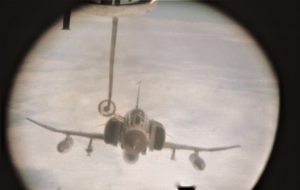
The RV was textbook, and the two ‘chicks’ were refuelled once more and accompanied towards Ascension. Around the top of descent, radio contact was made with the 4-ship, and we were coupled up shortly afterwards. With all six Phantoms on board, I set course for the pre-determined point on the west coast of the island from where the run across the island would commence. This was around Catherine Point, roughly half way up the western shore of Ascension. From there, I had planned with my nav team a course of just South of East across the relatively flat region of western Ascension Island. From around 2,000ft above mean sea level (amsl), we coasted in to the South of Cross Hill aiming towards the featureless Donkey Plain. I gently allowed the aircraft to climb as the higher ground was approaching.
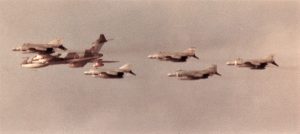
Visibility under the scattered afternoon clouds was good and navigation was straight forward. I could see Green Mountain (to the left) and South East Crater (to the right) in the distance ahead. The saddle of high ground created between my two aiming points was approximately 1,500ft amsl, and I adjusted the height of the formation to keep a safe separation from the ground whilst staying under the increasingly overcast cumulus cloud above.
In my earliest days of flying training, I learnt many lessons whilst flying the nimble Jet Provost around the Pennines and Lake District. In particular, I had learned about flying over the ‘saddle’ between two points of adjacent high ground, especially where the two peaks were topped by cloud cover. All flying in such conditions demands good forward visibility, and a safe clearance between the deck (i.e. ground) and the cloud base. To pull up into thick clouds can risk disorientation, but to press on with a diminishing clearance between the ground and base of the cloud does not bear thinking about. This predicament is known as the ‘sucker’s gap’. Hence the reason for my insistence from my counterpart before I left that he check when leaving the airfield that the area abeam Green Mountain would be clear of any significant cloud which would otherwise prejudice a safe flypast.
As I closed on the Governor’s residence where my reception committee would be well placed to see us fly by, I became increasingly concerned for the gap over the saddle to the south of my Green Mountain target. To add insult to injury, with a prevailing South-Easterly wind coming straight through the gap ahead, we were picking up some mechanical turbulence that would make tight formation keeping difficult at best. I called for the formation to “keep it tight” as I gingerly flew my Victor safely in the clear below the marked Cumulus base whilst maintaining a safe clearance from the rising ground below. The small internal window mirror by my left elbow enabled me to catch glimpses of my three chicks.
Tucked in tight on the port side, I was aware they were jostling up and down to hold position. My attention was such that I never did see the residence pass by on my left-hand side, as my full attention was directed towards managing the safe passage of my seven aircraft over the brow ahead. As we skirted the saddle and the ground mercifully fell away, I called “pushing” as I eased the nose down to stay clear of the cloud immediately above the formation. I asked my copilot to count his chicks on the starboard side, and one by one, we accounted for all six.
With some relief, I relaxed on the controls, and while slowly descending, I turned to the right as the formation coasted out. Continuing the starboard turn, the intention was to fly along the length of the runway from South East to North West, against the normal landing direction. With clearance from ATC, I rolled wings level at around 500ft above the runway surface.
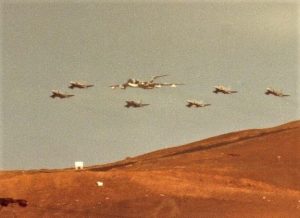
I flew the length of the runway with my six chicks in tow. Appearing from behind the volcano outcrop just to the south of the eastern end of the runway, our unannounced arrival to those personnel on the airfield must have been spectacular. Roughly half way along the runway, I called “Burner Burner GO” to signal my fast jet colleagues to let loose and accelerate ahead. In neat pairs, all six Phantoms overtook me in full reheat on either side in a cacophony of noise audible to me outside of my transparencies. Once they were clear ahead, I pulled back on the control column and wheeled it over to my left, flying neatly over the aircraft parking ramp. As I positioned downwind right hand, I lowered the flaps and landing gear, and continued in a continuous turn to starboard onto finals for runway 14.
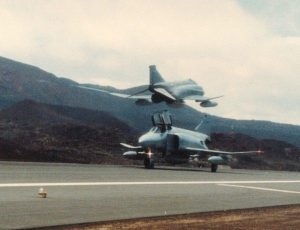
After touchdown, I streamed the brake parachute to kill the excess kinetic energy and started to brake the aircraft. In the space of time I had completed my ‘dumbbell’ to the South of the airfield, I was barely half way down the landing rollout when I came face to face with my lead Phantom screaming down the runway in the opposite direction. He was just a few feet above my cockpit roof. I felt he was low enough to collect the upper webbing straps of my braking parachute – deployed fully astern my rear fuselage. Nos.2 through 6 followed at barely 5 second intervals, all in full burner and rattling along at several hundred knots! I rapidly despatched the drag chute and expedited the back track to clear the runway for my compatriots.
I’m sure our flypast looked spectacular as we flew by the Governor’s residence. I was told some time later that the AOC’s convoy was running a little late on our carefully timed display. On hearing the noise from our approaching jets, the cars had pulled in to the side of the road and our expected audience rushed out of the vehicles to watch us fly by. In the rush, I learned that the AOC stumbled into a roadside ditch and sprained his ankle in the process. As for my flight commander colleague in charge of the Phantom flight, he shrugged off my observations about the sucker’s gap, and dismissed it with a view that there were bags of room!
Deployment to the Falkland Islands under ‘Operation Smelter’
Nine days later, I briefed the tanker crews and first Phantom pair as the formation leader for their deployment to the Falkland Islands under ‘Operation Smelter’. Because of the extreme distances involved, each pair of F-4s would require a supporting group of eight Victor K2s to feed them the necessary fuel en-route. The Victors would use a familiar cascading refuelling plan, successively topping up their mutual tankers which would then press on in company with their playmates. Each fast jet would take on six separate air-to-air refuellings before leaving the final accompanying tanker at a distance of nearly 2,500nm from Ascension Island. Flight duration for the Phantom crew was around 9 hours. In the event, the mission planned for 17 October 1982 had to be aborted after take-off because of one of the rare Victor hose drum unit failures. The operation was mounted 24 hours later, and successfully delivered the first air defence fighters to their new base at RAF Port Stanley on East Falkland Island.

